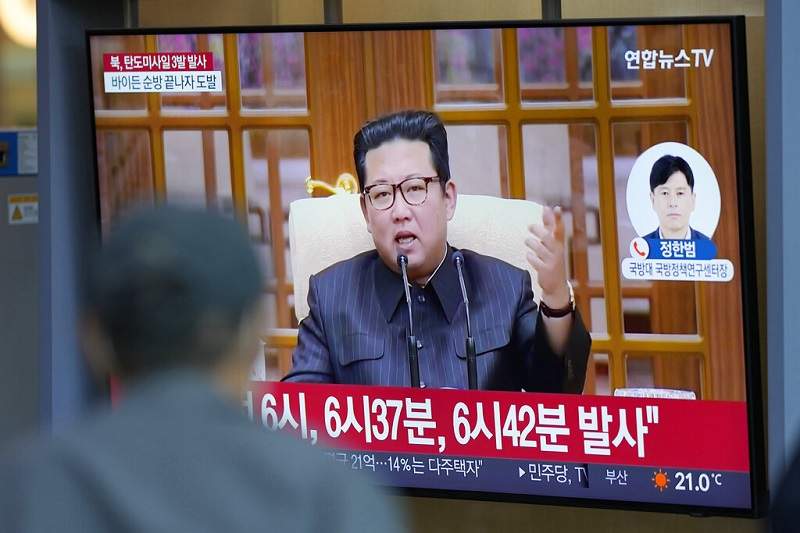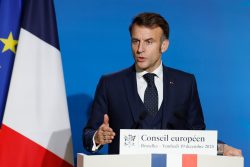
A man watches a TV screen showing a news program reporting about North Korea’s missile launch with a file footage of North Korean leader Kim Jong Un, at a train station in Seoul on Wednesday.
12:17 JST, May 25, 2022
SEOUL (AP) — North Korea test-launched a suspected intercontinental ballistic missile and two shorter-range weapons into the sea Wednesday, South Korea said, hours after President Joe Biden ended a trip to Asia where he reaffirmed the U.S. commitment to defend its allies in the face of the North’s nuclear threat.
If confirmed, it would be North Korea’s first ICBM launch in about two months. Breaking its 2018 moratorium on long-distance launches, North Korea in March claimed to have test-launched its longest-range missile as part of its development of functioning nuclear-armed missiles that can reach the American homeland.
The launches took place as North Korea made a much-disputed claim that its first domestic COVID-19 outbreak was weakening.
After an emergency national security council meeting, the South Korean government said the three weapons fired by North Korea included a suspected ICBM and two short-range ballistic missiles.
“North Korea’s sustained provocations can only result in stronger and faster South Korea-U.S. combined deterrence and can only deepen North Korea’s international isolation,” the South Korean government statement said. “(Our) government is maintaining constant readiness to strongly and effectively respond to any kind of North Korean provocation.”
South Korea’s military said the suspected ICBM reached a maximum height of 540 kilometers (335 miles) while traveling 360 kilometers (223 miles) east after being fired from the North’s capital region. The Joint Chiefs of Staff said the North apparently lost the second missile 20 kilometers (12 miles) into flight, while the third missile flew 760 kilometers (472 miles) on an apogee of 60 kilometers (37 miles).
A JCS statement said the U.S. and South Korean militaries fired two surface-to-surface missiles in response to the North Korean launches to demonstrate the allies’ striking capabilities. It said the allies had detected North Korea’s preparations for the launches in advance. It said South Korea’s air force on Tuesday conducted an “elephant walk” involving 30, fully-armed F-15K fighter jets parading along a runway in formation.
The U.S. Indo-Pacific Command earlier said the missile launches highlight “the destabilizing impact of (North Korea’s) illicit weapons program” though they didn’t pose an immediate threat to U.S. territory and its allies. A command statement said the U.S. commitment to the defense of the South Korea and Japan “remains ironclad.”
The White House said Biden has been briefed on the North Korean missile launches and will continue to be briefed as information develops.
Japanese Defense Minister Nobuo Kishi said the launches were “an act of provocation and absolutely impermissible.” He accused North Korea of pressing ahead with its weapons development program while “ignoring the people’s suffering amid the spread of the coronavirus in the country.”
The launches were North Korea’s 17th round of missile firings this year. Experts have said North Korea’s testing is aimed at modernizing its weapons arsenal and at applying pressure on its rivals to wrest sanctions relief and other concessions amid long-dormant nuclear diplomacy.
North Korea’s unusual pace in weapons tests this year included its first test of an intercontinental ballistic missile since 2017 in March. U.S. and South Korean intelligence officials have said North Korea could soon conduct its first nuclear test in nearly five years as well.
On March 24, North Korea conducted its first flight test of an intercontinental ballistic missile since November 2017, describing it as a demonstration of the Hwasong-17, its biggest-yet ICBM. However, South Korea’s military said the North instead may have fired a smaller Hwasong-15 ICBM it previously tested in 2017. Whichever it was, the missile flew longer and higher than any other weapon the North has ever tested and had the potential range to reach the entire U.S. mainland, experts say.
After their summit in Seoul on Saturday, Biden and Yoon said they would consider expanded military exercises to deter North Korean nuclear threats.
Biden brushed aside questions about any possible provocation by North Korea during his trip, saying, “We are prepared for anything North Korea does.” Asked if he had a message for the North’s leader, Kim Jong Un, Biden offered a clipped response: “Hello. Period.”
After his meetings in Seoul, Biden traveled to Japan and met with Prime Minister Fumio Kishida, where the leaders vowed to work closely to address security challenges, including North Korea’s nuclear and ballistic programs, and also what they called China’s “increasingly coercive” behavior in the region.
Hours before the North’s missile launches, U.S. State Department spokesperson Ned Price told reporters in Washington that North Korea may be on the verge of a major weapons test. “Our concern for another potential provocation, be it an ICBM launch, be a potential seventh nuclear weapons test, our concern has not abated in any way,” he said.
Before Wednesday’s launches, North Korea’s most recent missile tests occurred hours after the country on May 12 acknowledged its COVID-19 outbreak on its soil, after maintaining a widely disputed claim to be coronavirus-free for more than two years.
The country has said in the past few days that there has been “a positive sign” in its anti-virus campaign.
Since its admission of the outbreak of the highly contagious omicron variant, North Korea has said an unidentified fever has been spreading across the country since late April. It has stated how many people have fevers daily but identified just a fraction of the cases as COVID-19.
On Wednesday, North Korea’s state media said 115,970 more people fell ill due to feverish symptoms in the past 24-hour period but there was no additional death. It’s the second consecutive day that North Korea has claimed no fatality.
It said its total fever cases reached about 3 million people but only 68 of them died, an extremely low fatality rate if the illness is COVID-19 as suspected.
North Korea has limited testing capability for that many sick people, but some experts say it is also likely underreporting mortalities to prevent possible political damage on Kim.
North Korea has so far ignored South Korean and U.S. offers of humanitarian shipments of vaccines, medicines and other support items. Much of North Korea’s 26 million people remain unvaccinated and the country’s once-free socialist public health care system has been in shambles for decades.
"News Services" POPULAR ARTICLE
-

American Playwright Jeremy O. Harris Arrested in Japan on Alleged Drug Smuggling
-

Japan’s Nikkei Stock Average as JGB Yields, Yen Rise on Rate-Hike Bets
-

Japan’s Nikkei Stock Average Licks Wounds after Selloff Sparked by BOJ Hike Bets (UPDATE 1)
-

Japan’s Nikkei Stock Average Buoyed by Stable Yen; SoftBank’s Slide Caps Gains (UPDATE 1)
-

Japanese Bond Yields Zoom, Stocks Slide as Rate Hike Looms
JN ACCESS RANKING
-

Tokyo Economic Security Forum to Hold Inaugural Meeting Amid Tense Global Environment
-

Keidanren Chairman Yoshinobu Tsutsui Visits Kashiwazaki-Kariwa Nuclear Power Plant; Inspects New Emergency Safety System
-

Imports of Rare Earths from China Facing Delays, May Be Caused by Deterioration of Japan-China Relations
-

University of Tokyo Professor Discusses Japanese Economic Security in Interview Ahead of Forum
-

Japan Pulls out of Vietnam Nuclear Project, Complicating Hanoi’s Power Plans

























